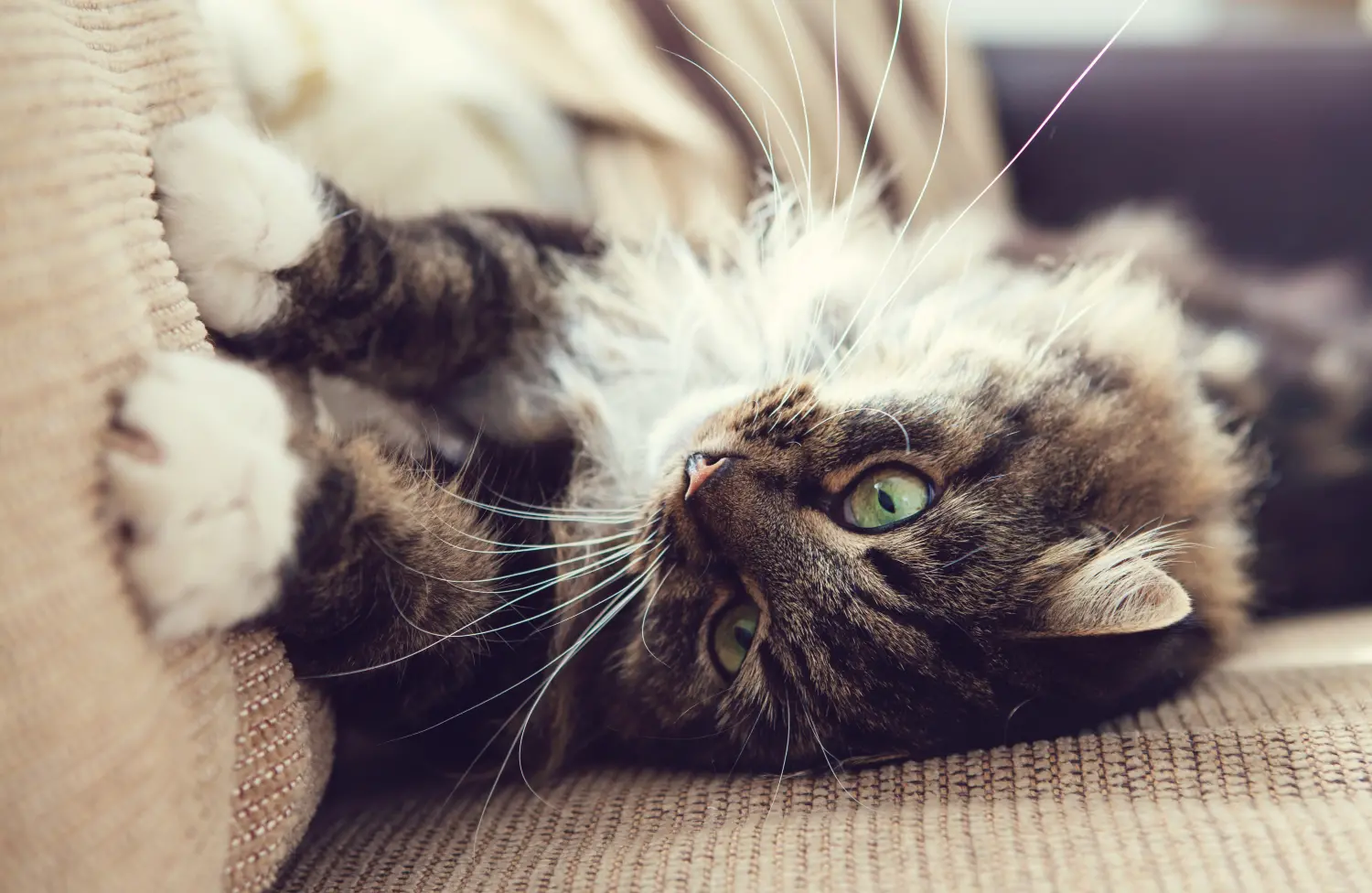
Cats are a unique species with some weird but endearing quirks. From kneading your thighs and leaping into boxes to their daily case of the zoomies, cats do some very curious things. Find out why do cats kneads and more odd cat behaviours.
Cats are fascinating creatures with unique behaviours that often leave us wondering about their motives. From making biscuits to loafing to talking to birds, understanding your cat's behaviour is a great way to help you better understand and communicate with your cat.
Here are some common cat behaviours that are easy to spot and decipher:
- Closing Their Eyes at You: Cats will look at you and purposefully close their eyes when they are comfortable with you. This usually means feeling safe and trusting you enough to take their eyes off you.
- The Cat Loaf: Most cat families have seen the famous cat loaf position. With all four legs tucked under their body and the tail tucked to the side, your cat will look curiously like a loaf of bread. Beyond being absolutely adorable, this position is a way to conserve body heat when resting.
- Love Bites: Some cats give love bites. A gentle nibble is a common way for cats to show affection to other cats. So if your cat lovingly gnaws on you, then congratulations, your cat thinks you're a really big cat.
- Nail Biting: Cats chew on their claws to keep them healthy. It's a normal part of their grooming routine. It may seem like they are trying to sharpen them, but they are actually just removing flakes of shedding nails and keeping them clean and healthy.
- Puss in Boots Eyes: Your cat's pupils dilate quickly to allow them to adjust to different lighting and to focus on a target when playing or hunting. Big dilated pupils often indicate excitement, fear, or anxiety.
- The Jaw Drop: Have you ever seen your cat sniff something and then let their jaw slack as if surprised? Surprisingly, this is not a sign of disgust or shock but rather a way to smell a scent more deeply. This is used when your cat is hunting, mating, and exploring and new environment.
- Laptop/Keyboard Obsession: You are typing on your keyboard, and all of a sudden, a needy cat decides to stroll over and plop down on your keyboard. Some cats do it for attention, but more often, they seek out warm spots to lay, and this includes your laptop. You might also find them lying on your gaming console, heating vents, and rays of sunshine.
All cat behaviours are a bit quirky, but some are more peculiar than others. One of the most endearing behaviours exhibited by cats is kneading, or as we like to call it, making biscuits.
You may have witnessed your feline friend rhythmically pressing their paws against soft surfaces like blankets, pillows, or even your lap. But have you ever wondered why do cats make biscuits? In this article, we will break down some of the funniest and cutest cat behaviours.
Why Do Cats Knead?
Curled up in your lap, purring contently, your beloved feline companion suddenly starts kneading your thighs with their paws. As you feel the rhythmic kneading motion, have you ever wondered why do cats knead?
Many cat parents note that cat kneading is just one of the cutest things their furry friends do, but they often wonder why exactly they do it. This blog post will delve into the intriguing world of feline kneading (or making biscuits!) and uncover the various reasons behind this curious behaviour.
While not all cats knead, this endearing behaviour is commonly observed among feline companions. Kneading, characterized by rhythmic paw movements against surfaces or objects, is often associated with feelings of comfort and contentment.
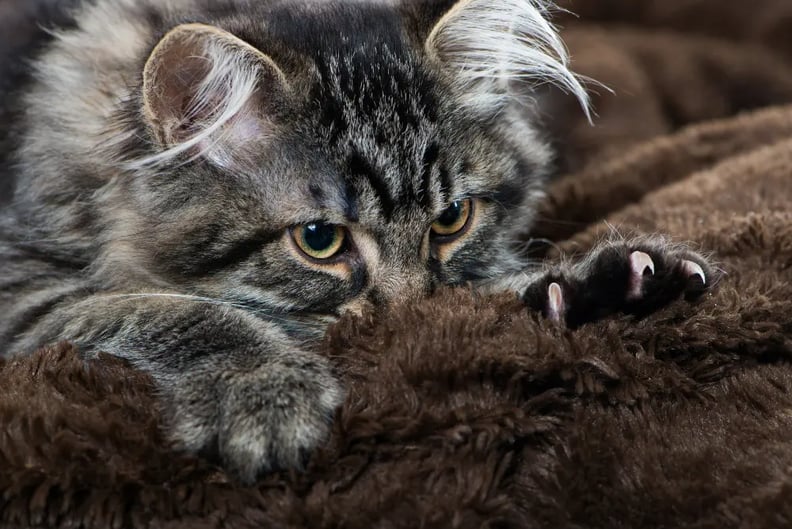
What is Cat Kneading?
Some cats engage in this ritual from an early age, imprinting it as a natural instinct. Whether kneading blankets, pillows, or even their human caregivers, this behaviour is believed to harken back to their kittenhood, where they instinctively kneaded their mother's mammary glands to stimulate milk production.
For cats that continue this behaviour into adulthood, it can serve as a way to express relaxation, happiness or simply a means to mark their territory.
1. Instinctual Behaviour
kneading is deeply rooted in our furry friends' primal instincts. It harks back to their distant ancestors, the majestic wildcats who roamed the untamed lands. Back then, kneading played a crucial role in their survival and adaptation.
Imagine a litter of adorable wildcat kittens nestled in their den. As they nurse from their mother, their tiny paws instinctively push and pull against her belly. This rhythmic motion stimulates milk flow, ensuring their nourishment and growth. Fast forward to the present day, and domesticated cats have retained this ancient kneading behaviour as a remnant of their wild heritage.
But why does kneading persist beyond kittenhood? Well, it turns out that the instinctual reasons behind this behaviour go beyond nourishment alone.
Kneading also served as a way for wildcats to prepare their sleeping areas, ensuring a comfortable and safe spot in the wilderness. By kneading the ground or foliage, they would soften the surface and create a cozy nest to rest upon.
2. Territorial Marking
Our furry friends have an ingenious way of claiming ownership over everything they touch, and it involves those adorable little paws. When cats knead, they flex their paw muscles and leave their special scent behind, like a signature fragrance.
Think of it as a feline version of graffiti, but much cuter and with zero property damage. With each rhythmic press and release, your cat's paws release scent pheromones from special glands.
It's their way of saying - "This spot is mine, and don't you forget it!"
Cats have an instinctual urge to establish their domain and create a sense of familiarity. By kneading objects around your home, they're making it abundantly clear to everyone (including other cats, if they're around) that this is their turf.
It's like they're saying, "Move over, world! This couch, this blanket, and even this pair of socks belong to me!" And let's be honest, who can resist a cat claiming possession of random items with such pomp and confidence?
3. Relaxation and Contentment
Kneading is often associated with relaxation and contentment. When cats knead, they enter a state of bliss, purring and displaying signs of tranquillity. You may even notice their eyes totally zoned out. Some cats even drool!
The rhythmic motion of pushing their paws against a soft surface can have a soothing effect, similar to how humans might engage in activities like squeezing stress balls or massaging their temples to relax.
The act of kneading also releases endorphins, those magical feel-good chemicals that can whisk away stress and bring on a sense of calm. It's like a kitty spa treatment—a self-soothing technique that helps cats unwind from the demands of their daily feline adventures.
4. Stretching and Flexing Muscles
When cats knead, their paws work like miniature personal trainers, encouraging their muscles to lengthen and extend. Each push and pull against a surface provides a delightful stretch for their shoulders, forelimbs, and even their back muscles.
It's like a kitty version of the downward-facing cat pose—pawsome flexibility at its finest!
As natural-born athletes, cats understand the importance of maintaining supple muscles and limber joints. Just like human athletes warm up before a workout, cats use kneading as a prelude to their various adventures.
Whether it's a daring leap onto a high shelf or a lightning-fast chase after a pesky cat toy, their kneading routine helps ensure they're ready to pounce with agility and grace.
Additionally, kneading serves as a fantastic way for cats to engage their core muscles. Their abdominal muscles contract as they push against a surface, giving them a mini-workout. It's like having a built-in exercise routine while enjoying the simple pleasure of kneading.
5. Seeking Attention or Affection
Picture this: you're sitting on the couch, engrossed in a book or binge-watching your favourite show, when suddenly, your cat jumps into your lap. Before you know it, those adorable little paws are rhythmically pushing and pulling against your legs as if they're practising for a feline bake-off.
So, what's the deal with this kneading craze? Our furry friends are natural-born attention seekers, and kneading is their way of demanding the spotlight. They've got a flair for drama and know exactly how to capture your undivided attention.
When a cat kneads, it's like they're saying, "Hey, Hooman! Look at me! I'm here, and I need some lovin'!" It's their purrfectly adorable method of saying - "Pay attention to me; I deserve all the cuddles and ear scratches in the world!"
6. To Attract a Mate
Kneading is associated with comfort and affection and plays a fascinating role in the feline mating ritual. Cats have unique ways of communicating their readiness and desirability when it comes to attracting a mate.
Kneading is one such behaviour that serves as a form of courtship and can play a part in the mating dance. So basically, your cat is flirting!
During the mating season, female cats, known as queens, may exhibit kneading behaviours as a means to signal their receptiveness to potential mates. The act of kneading can be seen as a way for a female cat to indicate her fertility and availability.
Through rhythmic paw movements, males communicate their fitness and readiness to mate, hoping to catch the attention of receptive females.
It's important to note that not all cats knead for mating purposes, and this behaviour isn’t the only reason cats knead.
Why Do Cats Knead Their Owners?
Have you noticed that your furbaby loves to knead you all the time? Don’t worry- it’s completely normal (and super adorable)!
Cats knead their owners as a loving and comforting gesture stemming from their early bonding experiences and as a way to mark their territory with scent glands on their paws.
This cute and endearing cat behaviour is proof that your cat feels comfortable with you, safe with you, and, more importantly, bonded with you. So let them make as many biscuits with your leg as they want.
A kneading cat is also a good way to decide if your cat's nails are too long. No matter how loving and gentle your cat kneads, a razor-sharp claw poking your stomach will surely get your attention.
Cat Kneading is Still Somewhat of a Mystery
While the exact reasons why cats knead may vary from one feline to another, it is clear that this cat behaviour holds a special place in the feline world.
From instinctual nursing behaviour to territorial marking and seeking comfort, kneading is a multifaceted behaviour that showcases the complexity of our beloved feline friends.
So next time your kitty unleashes their kneading prowess, embrace the opportunity to give them the royal treatment.
Let them have their fifteen minutes of fame and shower them with cuddles, scratches, and all the love they desire. After all, cats have mastered the art of capturing our hearts, one adorable knead at a time.
Why Do Cats Like Boxes?
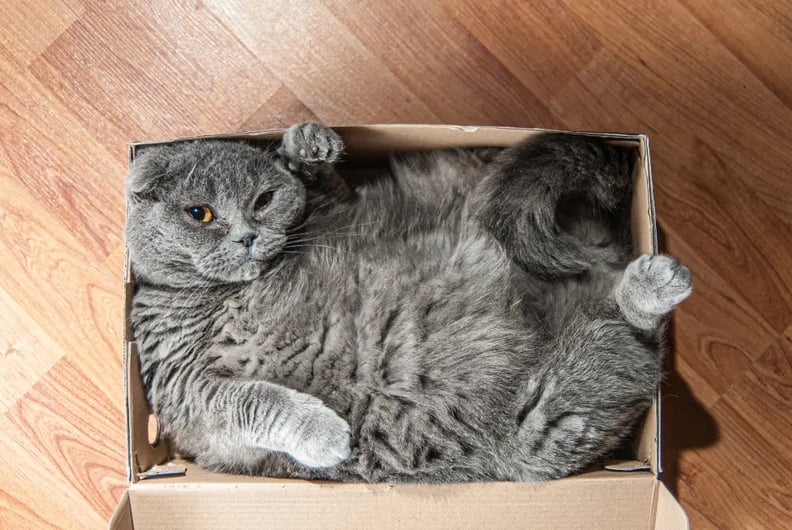
All cat owners know the saying - If I Fits I Sits. No matter how small or awkwardly shaped the box is, cats will turn into a liquid and fill the container with their floofy bodies.
Have you ever wondered why your feline friend seems to have an inexplicable fascination with cardboard boxes? It's a mystery that has intrigued cat owners for years, and while we still don't have all the answers to why cats like boxes, we do have some pretty good guesses.
From the tiniest kitten to the largest Maine Coon, cats of all shapes and sizes can't resist the allure of a simple box. So, why do cats like squares?
And it's not just boxes. They will squeeze into almost any container and sit on any square-ish shape left on the floor. Laundry baskets, reusable shopping bags, towels, just to name a few.
But what drives this behaviour? Is it an instinctual need for security and comfort, or is there something more to it?
The Psychology Behind Cats and Boxes
So, why do cats like boxes and bags? Cats are known to be curious creatures, and their love for boxes is no exception. But what is it about boxes that captivate their attention and spark their curiosity?
One theory suggests that cats are attracted to boxes because they provide a sense of security and comfort. When a cat enters a box, they have a 360-degree view of their surroundings, allowing them to feel protected from potential threats.
Additionally, the confined space of a box creates a cozy and warm environment, similar to the feeling of being nestled in a den or a cave. This sense of security and comfort can help reduce stress and anxiety in cats, making boxes a go-to spot for relaxation.
Cat Box Forts
Now you have some ideas as to why do cats like to sit in boxes, but what can you do with this knowledge?
If your kitty is content to perch in a box and stare at their surroundings, let them! In fact, you can get creative and use your spare boxes to make a DIY Cat Box Fort. It can be as simple or as extravagant as you want.
Here is a super simple and creative cat house made from boxes:
Why Do Cats Rub Up Against You?
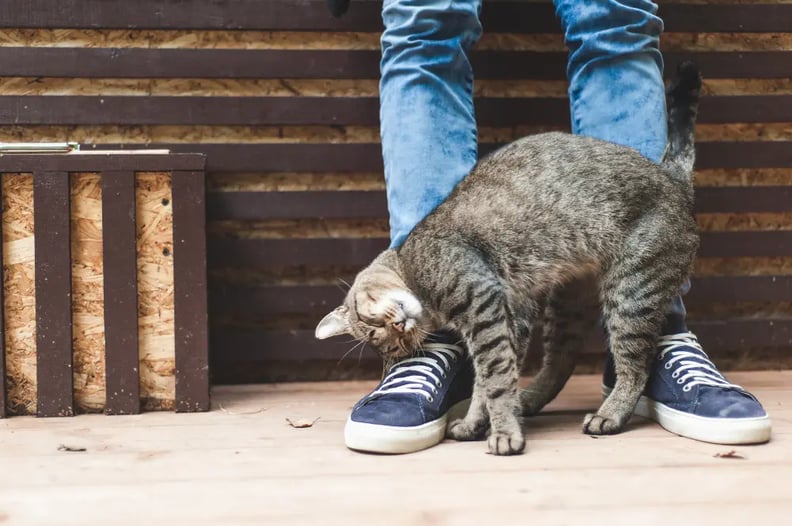
Cats are mysterious creatures known for their independent nature and unpredictable behaviours. One of the most endearing and puzzling gestures they often display is rubbing their faces against their human companions.
Why do cats rub against you? Why do cats headbutt you? And it's not just you. Why do cats rub their faces on corners and furniture?
Well, the answer lies in the fascinating science behind this adorable behaviour.
Cats Like to Claim Their Humans
As it turns out, cats have scent glands located on their faces, specifically around their cheeks, chin, and forehead. When they rub against you, they show their love and affection and mark their territory.
This behaviour, known as bunting, is a way for cats to establish their scent and claim you as their own. But there's more to it than just territorial marking.
You are actively participating in this bonding process by allowing your cat to rub its face against you. It's a way for you to show your cat that you accept and value its presence. This simple act of affection can go a long way in building trust and strengthening your relationship with your furry companion.
Next time you find yourself asking why do cats rub their face on everything, you can assume your cat is calling dibs on you and your home.
Demanding Attention
Why does my cat headbutt me? Sometimes cats will come up and gently, or not so gently, boop you with their head and then rub their face on you.
This is most likely an attention-seeking behaviour. Maybe your kitty wants some love or a nice warm lap to cuddle up on. Maybe she's letting you know her food bowl is empty, or she wants a tasty cat treat.
It's not just you, either. Some cats will headbutt their animal siblings to ask for affection, too.
The Curious Nature of Cats
There is another possible answer to why do cats rub against your legs. Apart from marking territory, cats also rub their faces on objects and people as a form of exploration.
Their sense of smell is highly sensitive, and by rubbing their faces, they can gather information about their environment.
They can detect scents left behind by other animals or even the lingering scent of food. It's their way of gathering valuable information about their surroundings and assessing potential threats or opportunities.
Why Do Cats Shake Their Tail?
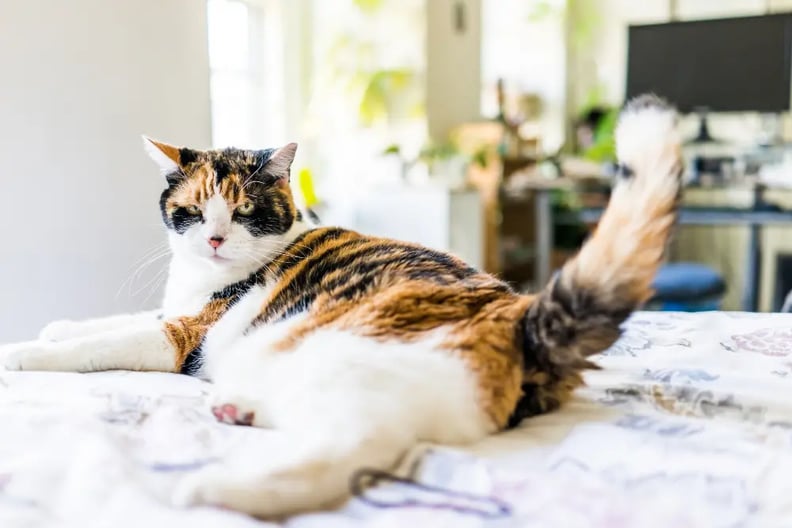
Cats are known for their elegant and expressive tails, which can move in various ways, each conveying a different message. But what are they trying to tell you, and why do cats shake their tails? Whether it's a gracefully sweeping motion or a frantic rattle, your cat's tail is a powerful tool they use to express themselves.
Cat Tail Wagging Meaning
Why do cats wag their tails? What does it mean when a cat shakes its tail? Whether your cat quivers her tail like a rattlesnake or rhythmically snaps her tail back and forth, she's trying to communicate her mood or intentions to you.
Understanding the different types of cat tail movements is essential in deciphering your cat's communication. Here are some common tail movements you may observe:
-
- The Upright Tail: When your cat's tail is straight up in the air, it signifies confidence and contentment. It's their way of saying, "I'm feeling great!"
- The Curved Tail: A slightly curved tail indicates a friendly and approachable mood. Your cat is likely feeling sociable and open to interaction.
- The Puffed-Up Tail: If your cat's tail is puffed up like a bottle brush, it's a clear sign of agitation or fear. This defensive posture is a warning to back off and give your cat some space.
- The Tucked Tail: When your cat tucks their tail tightly against their body, it suggests anxiety or submission. They may be feeling scared or unsure about their surroundings.
- The Slow Tail Wag: A slow, gentle swish from side to side often indicates curiosity. Your cat is intrigued by something and is assessing the situation.
- The Rapid Tail Wag: On the other hand, a rapid tail wag accompanied by an upright stance can be a sign of excitement or anticipation. Your cat may be getting ready to pounce or play.
- The Cat Tail Shake: The cat tail shake is even more frantic than the rapid tail wag. This rattlesnake-like cat tail quiver is often a sign of excitement and anticipation.
Understanding these different types of cat tail movements is the first step in deciphering what your cat is trying to communicate. However, it's important to remember that each cat is unique, and their tail language may vary slightly.
Cat Tail Wagging Misconceptions:
While cat tail wagging is a fascinating form of communication, there are several misconceptions that need to be addressed. These misconceptions can lead to misunderstandings and misinterpretations of your cat's messages.
Here are some common misconceptions about cat tail wagging:
- Tail wagging always indicates happiness: Unlike dogs, tail wagging in cats does not always signify happiness. Cats have a more complex tail language, and their tail movements can convey a range of emotions, including fear, aggression, and annoyance.
- A straight-up tail always means a friendly cat: While a straight-up tail can indicate confidence and contentment, it should not be assumed that every cat with an upright tail is friendly. Other cat body language cues, such as facial expressions and ear positions, should be considered to assess a cat's mood accurately.
- Puffed-up tail always means aggression: While a puffed-up tail is often associated with aggression or fear, it can also indicate excitement or arousal. It's important to consider other contextual cues to determine the underlying emotion behind the tail position.
- All cats wag their tails in the same way: Each cat has their own unique way of tail wagging, and tail language can vary between individuals. Observing your cat's specific tail movements and patterns is important to understand their unique communication style.
You can approach your cat's tail wagging with a more informed and accurate perspective by dispelling these common misconceptions. This will help you better understand and respond to your cat's needs and emotions.
What Does it Mean When Cats Pur?
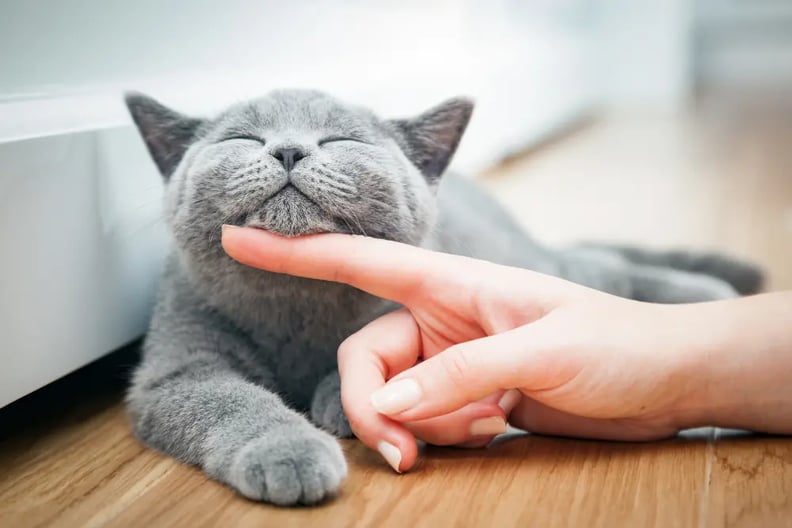
Cats are known for their enigmatic nature, and one of the ways they communicate is through purring. But why do cats purr?
Contrary to popular belief, purring is not always a sign of contentment. While it is true that cats often purr when they are relaxed and comfortable, purring can also be a way for them to communicate other emotions.
For example, cats may purr when they are in pain or distress as a way to self-soothe. Additionally, mother cats often purr to comfort their kittens and create a sense of security.
So, while purring is commonly associated with happiness, it is important to consider the context and other body language cues when interpreting your cat's purrs.
Understanding Cat Purring
Understanding the reasons behind your cat's purring can help you better connect with them and provide the care they need.
Whether it's a content purr that signifies relaxation or a purr that signals discomfort, paying attention to your cat's purring can provide valuable insights into their emotional state. Let's explore the different types of purrs and their meanings to deepen our understanding of our feline companions.
Cats have a wide range of purrs, each with its own unique meaning. By familiarizing yourself with the different types of purrs, you'll be able to decipher your cat's emotions more accurately.
-
- The Content Purr: This is the most common type of purr and is typically associated with relaxation and contentment. Your cat may emit a soft, steady purr when they are feeling comfortable and at ease. It's a reassuring sound that signifies your cat is happy and content in their environment.
- The Attention-seeking Purr: If your cat is seeking your attention or wants something, they may produce a slightly louder and more insistent purr. This purr is often accompanied by rubbing against your legs or nuzzling your hand. It's their way of letting you know they want your affection, playtime, or even a treat.
- The Stress Purr: Cats can also purr when they are stressed or anxious. This purr may be less rhythmic and more irregular compared to a content purr. It's important to pay attention to other signs of stress, such as dilated pupils, aggressive behaviour, or hiding, as these can help you determine if your cat is purring due to stress.
Understanding the different types of purrs and their meanings is crucial for accurately interpreting your cat's emotions. By paying attention to the context and accompanying body language, you'll be able to decipher what your cat is trying to communicate.
How To Respond to Cat Purring
Knowing how to respond appropriately is essential now that you've learned how to decipher your cat's purrs. Here are some ways you can acknowledge and respond to your cat's purring:
- Provide comfort and affection: If your cat is purring due to contentment, respond by offering gentle petting, cuddles, or playtime. This positive reinforcement will strengthen the bond between you and your cat.
- Assess the situation: If your cat's purring seems to indicate stress or discomfort, assess the environment for potential triggers. Create a calm and safe space for your cat to alleviate their stress.
- Consult a veterinarian: If you notice a sudden change in your cat's purring behaviour or if they are purring excessively without an apparent cause, it's advisable to consult a veterinarian. Excessive purring can sometimes be a sign of an underlying health issue that requires attention.
Remember, each cat is unique, and their preferences for interaction may vary. Pay attention to your cat's individual preferences and respond accordingly to ensure a harmonious relationship.
Other Cat Noises and Their Meanings
Purring is one of our favourite cat noises, but your cat is capable of more noises than you might think. In fact, some cats are extremely talkative, whether you'd like them to be or not.
Different cat noises are used in different situations. Recognizing and understanding the most common cat noises can help you better bond with your cat and provide them with a stimulating and enriching routine.
Why Do Cats Meow at You?
Unlike many other cat noises, meows are believed to be a method of communication that cats adapted to interact with humans. Cats almost never meow at other cats to communicate.
Wondering why do cats meow at humans? It's actually unclear because this method of communication is so versatile. Cat meows need to be interpreted situationally.
If your cat meows early in the morning, she might be asking for breakfast. If she meows near a door, she might be asking to go outside. Your cat's meows will be unique to your routine and environment.
The other thing to consider is the volume and urgency of the meow. Why do cats meow a lot? Cats that meow frantically or louder than normal might be expressing anxiety. They may also have learned that the louder they yell, the quicker you'll respond.
Why Do Cats Chirp?
Our favourite cat sound and the most difficult to explain is the chirp or chatter. A chatter is a high-pitched but quiet, almost clicking noise that cats make. They make this noise by quivering their jaws.
Why do cats chatter? Chattering is most often a sign of excitement or anticipation reserved for hunting and stalking prey. You'll often catch your cat making this odd noise when staring out the window at birds, bugs, and other wildlife.
Why do cats chatter when they see a bird? Your cat is a natural-born hunter, and even though there is zero chance that your cat will ever catch a bird, the instinctual response to chatter, stalk, and even chase their potential prey is irresistible.
Why Do Cats Trill?
Cat trilling is a fun sound that many cat owners not only love to hear but we often parrot back by making a rolled R sound with an upward inflection. We don't quite nail it as well as cats, though.
A trill is a sort of mix between a purr and a meow with a raised tone at the end of the sound. This sound is brief but adorable. So, why do cats trill at humans?
The most likely answer is that they use this trill as a greeting for their humans. You'll often hear this sound when you enter a room that your cat is in. It's often used by cats who are woken by their people or when you touch them.
You might even hear them trilling when they jump up on furniture, counters, or ledges as a way to announce their presence.
No matter how your cat talks, it's a good idea to listen and understand why they are so vocal. Your cat learns over time how to most effectively communicate with you, so it's important to take the time to learn the different sounds they make and know how to respond appropriately.
Knowing the difference between happy sounds, scared sounds, and even sounds of pain can help you create a safe, enriching, and fun environment for your cat.
What Are Cat Zoomies?
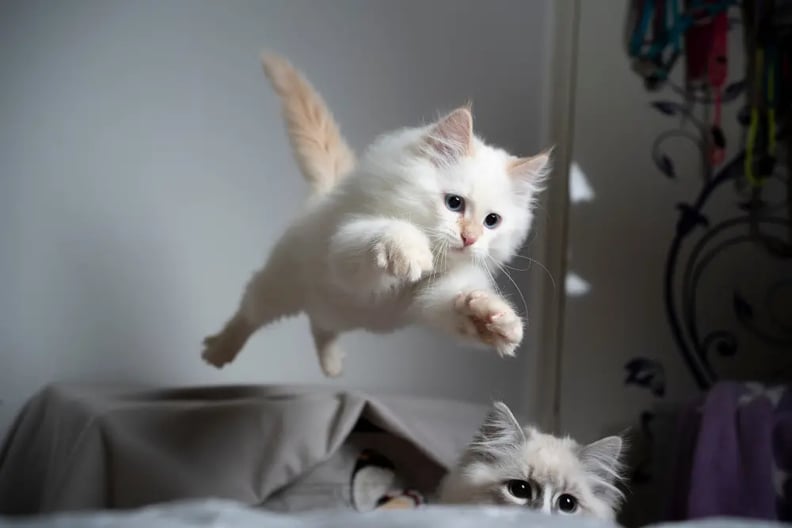
Cat zoomies, also known as the "crazy hour," refer to those moments when a cat suddenly becomes hyperactive and darts around the house with seemingly boundless energy.
These episodes can last anywhere from a few minutes to half an hour and often leave cat owners amused and perplexed. The behaviour typically involves sprinting, pouncing, and leaping, accompanied by playful chirps or meows.
While the exact cause of cat zoomies is still a subject of debate among experts, several theories shed light on this peculiar behaviour.
One theory suggests that cat zoomies are an innate hunting behaviour. Cats in the wild often experience bursts of energy when hunting prey, and these zoomies may be an instinctual way for domestic cats to release pent-up energy and mimic their hunting instincts.
Another theory proposes that zoomies serve as a form of self-play, allowing cats to burn off excess energy and engage in physical exercise. Zoomies may also be linked to a cat's need for mental stimulation and environmental enrichment.
Why Do Cats Get The Zoomies?
We must delve into our feline friends' physiology and anatomy to understand the science behind cat zoomies.
Cats are natural predators, and their bodies are designed for agility, speed, and explosive bursts of energy. They have powerful leg muscles, flexible spines, and sharp claws that allow them to quickly change direction and chase prey.
Additionally, cats have a unique skeletal structure that enables them to maintain balance while running at high speeds. These physical attributes and their innate hunting instincts contribute to their ability to engage in zoomies.
From a neurological perspective, cat zoomies are thought to be triggered by the release of excess energy in the form of dopamine, a neurotransmitter associated with pleasure and reward.
When cats experience heightened arousal or excitement, dopamine is released in their brains, leading to an increase in energy levels and a desire to engage in physical activity.
This surge of dopamine can result in the sudden onset of zoomies, causing cats to engage in rapid and playful behaviour.
When Do Cats Get Zoomies?
Cat zoomies can happen anytime, but some cats get zoomies at strange or unfortunate times. Cat zoomies at night are a particularly frustrating experience. Cats are most active at dusk and dawn, so when you are counting sheep, your cat might be loudly running a marathon around your house.
Providing safe and interactive cat toys can help redirect their excess energy towards quieter activities that won't disrupt your sleep schedule.
One of the funnier cases of this high-energy habit is cat zoomies after pooping. There is something about a good poop that gives cats a surge of energy. Maybe they are more comfortable and a little bit lighter, but it's not uncommon for cats to take a few laps around the house after leaving the litter box.
Understanding Your Cat
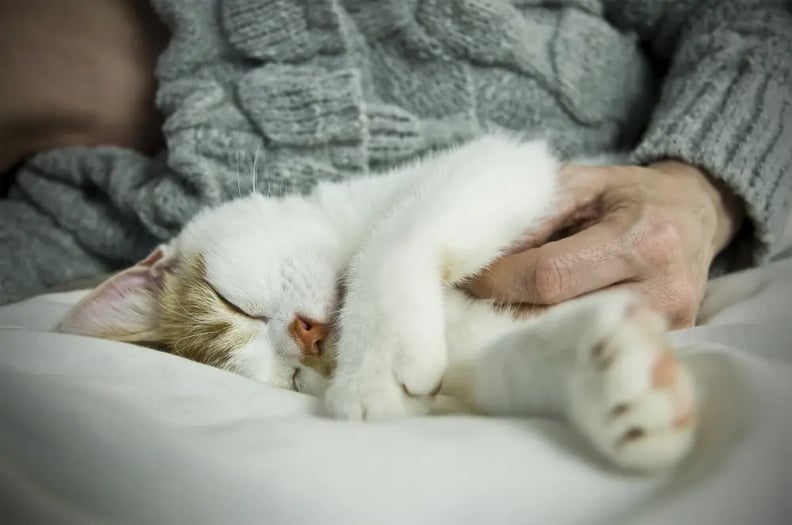
Every cat parent has experienced a moment when you see them do something truly ridiculous, and you think, "What is happening? Explain yourself!"
It's one of the reasons we love cats. They have weird, quirky, and unique personalities that provide us with daily entertainment but sometimes leave us confused.
The more you know about why cats do the funny things they do, the easier it is to respond to them appropriately, bond with them, and keep them happy and safe.
Is your cat a weirdo? Show us your cat's favourite odd behaviour by tagging us at @homesalivepets
.png?width=200&height=66&name=logo%20(1).png)



